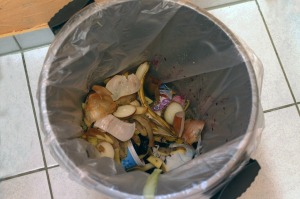Everyone talks about producing more food for the growing global population to end hunger, but stopping food wastage is equally important.
Poverty and world hunger are serious global problems that have been further aggravated each year by growing populations and the fall of the global economy.
On top of all that, it’s also shocking to know that one third of all the food produced around the world is wasted due to lack of food management.
 This means that one third of all agricultural resources, such as agricultural land, water for irrigation, energy for running agricultural equipment, processing, packaging, storage and transportation are also wasted. We are even creating a third more in carbon emissions from these activities, that are not necessary.
This means that one third of all agricultural resources, such as agricultural land, water for irrigation, energy for running agricultural equipment, processing, packaging, storage and transportation are also wasted. We are even creating a third more in carbon emissions from these activities, that are not necessary.
Do you agree that we waste too much food? Please leave your comment on this post on our Facebook Page.
Some shocking facts about world hunger
- Hunger is the world’s number 1 health risk; it kills more people every year than AIDS, malaria, and tuberculosis combined. (World Food Program)
- Despite all the food produced around the world, about 13% of the world’s population are undernourished. That is over 925 million people who consume a diet of less than 2,100 calories a day.
- Hunger, poverty and related medical costs amount to $30 billion each year.
- Even though enough food is produced in America, one out of every eight children under the age of twelve in the U.S. goes to bed hungry every night. Facts and Figures – World Hunger and Poverty
- Poor nutrition is causing the deaths of nearly 3.1 million children under five, each year.
- One out of six children — roughly 100 million — in developing countries is underweight.
- One in seven people in the world will go to bed hungry tonight. (World Food Program)
Some shocking facts about food wastage
- It’s estimated that about 1/3 of the food produced in the United States is wasted in the food supply and storage processes.
- America’s’ per capita food waste has increased by 50% since 1974.
- Food waste also costs money for the government, who have to dispose of it. Ultimately, it ends up costing taxpayers twice, who already paid to buy the food once. The environmental Protection Agency (EPA) has reported that discarded food is the “single largest component of municipal solid waste reaching landfills and incinerators.” – The environmental Protection Agency (EPA). Food waste costs Americans between 100 to 160 billion dollars a year. (This estimate is by Jonathan Bloom, author of American Wasteland.)
Why food is wasted
 I often wonder why we waste food when there are millions of people around the world who literally die from hunger. There are several reasons why food is wasted from production to distribution and storage. These reasons are given below.
I often wonder why we waste food when there are millions of people around the world who literally die from hunger. There are several reasons why food is wasted from production to distribution and storage. These reasons are given below.
- Some crops are left unharvested in developing countries because their market price falls, making it not cost-effective to use resources and labor to harvest. In some cases, as well, the crop quality may not meet the standards of supermarkets or the expectations of consumers.
- Some food costs too much to store and is thrown away by producers.
- A large portion of food wastage occurs in American homes. Most household waste occurs due to spoilage, overcooking and improper storage processes. On average, an American household will throw away 20 pounds of food every month.
- Households and supermarkets throw away food which has passed the “use by” date, even though the food has not spoiled.
- Restaurant waste is due to providing super-sized servings of food.
Take steps to minimize food waste
As a child, I have heard the saying, “Don’t waste your food, there are hungry children in Africa.” I felt guilty about wasting food from a very early age.
The food that is wasted globally is enough to feed over 1 billion hungry people around the world.
It is possible to reduce world hunger if we all do our share of reducing food waste. There are steps we can take to ensure that we waste a minimum amount of food. Below are a few suggestions to minimize food waste.
1. Buy smart
Only buy what you will eat and plan your grocery shopping. Before you buy, take inventory of your cupboards and fridge. Buy enough food to last a few days, but not more because most food will last only a week in your fridge. Also try to buy locally and seasonally. Check upcoming expiration dates of all food and rotate items in your cupboards to bring the upcoming dates to the front.
2. Store better
Some foods need special care and processing for storage. Learn how to store each type of food, as they will last longer.
3. Check your fridge
When you are planning a meal, check and see what you already have in your fridge. Eat the foods that are close to their expiry dates. Also make sure that your fridge is running properly.
4. Use leftovers
Try to use all your leftover food from previous meals. Make a note on the fridge door of what leftovers you add to the fridge each day, so you don’t forget about them or lose track of how old they are.
When cooking, use every bit of whatever you are using to cook. Freeze your leftover food and take it to work with you for lunch at a later date. If you only have a portion of vegetables left over, for example, add them to one part of a sectioned leftover dish and place in the freezer. If another day you have some potatoes left, add them to the same dish. Eventually you’ll have a full meal.
5. Compost food
If you have spoiled food in your fridge, you can still use it. Compost your food waste and peels and turn them into fertilizer for your kitchen garden.
6. Donate food
If you feel that you are not going to eat something before it spoils or expires, why not donate it to a local charity?
Conclusion
 Food wastage has a significant impact on those in poverty as well as our environment, ecology and economy. A significant amount of land, energy and resources are used in producing food. Wasted food can also be put to other uses like turning it into compost and using it as fertilizer.
Food wastage has a significant impact on those in poverty as well as our environment, ecology and economy. A significant amount of land, energy and resources are used in producing food. Wasted food can also be put to other uses like turning it into compost and using it as fertilizer.
It’s not that we don’t produce enough food for everybody. We do have enough to feed everyone, but we need to manage our food better. We need to make sure that we utilize all of our resources efficiently and don’t waste what we have. If you cannot use it, let someone else have it. Better food management and storage of food will significantly reduce food shortages and help to increase available food around the world.
Please share this article and help us spread awareness about food waste.
View the replay of our Huddle Hangout with Janie Gianotsos, Director of Marketing & Community Relations at the Food Bank of the Rockies, where she discussed with us the very real problem that hunger is right here in the USA.
We’d love to hear from you about this topic. Please visit our Facebook Page and leave a comment or leave one below in the comment box.
Source: Nourish The Planet
Related topics and resources:
- Minimize Food Waste Easily
- Global Food Waste – How To Minimize Waste
- Nationwide Donation Programs to Minimize Food Waste
- The Progressive Increase of Food Waste in America and Its Environmental Impact
- Hunger Statistics | WFP | United Nations World Food Programme – Fighting Hunger Worldwide
- 18 Surprising Facts That Will Motivate You to Stop Wasting Food | Alternet



